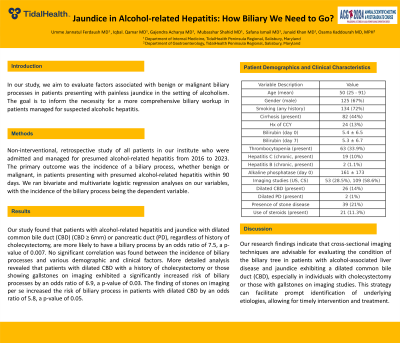Tuesday Poster Session
Category: Biliary/Pancreas
P3451 - Jaundice in Alcohol-related Hepatitis: How Biliary We Need to Go?
Tuesday, October 29, 2024
10:30 AM - 4:00 PM ET
Location: Exhibit Hall E

Has Audio

Umme Jannatul Ferdaush, MD
Tidal Health
Lewes, DE
Presenting Author(s)
Qamar Iqbal, MD, Gajendra Acharya, MD, Mubasshar Shahid, MD, Safana Ismail, MD, Junaid Khan, MD, Umme Jannatul Ferdaush, MD, Osama Kaddourah, MS, MD
Tidal Health, Salisbury, MD
Introduction: In our study, we aim to evaluate factors associated with benign or malignant biliary processes in patients presenting with painless jaundice in the setting of alcoholism. The goal is to inform the necessity for a more comprehensive biliary workup in patients managed for suspected alcoholic hepatitis.
Methods: Non-interventional, retrospective study of all patients in our institute who were admitted and managed for presumed alcohol-related hepatitis from 2016 to 2023. The primary outcome was the incidence of a biliary process, whether benign or malignant, in patients presenting with presumed alcohol-related hepatitis within 90 days. We ran bivariate and multivariate logistic regression analyses on our variables, with the incidence of the biliary process being the dependent variable.
Results: Our cohort consisted of 186 patients who presented between the year 2016 and 2023. Variables collected are described in table (1). Our study found that patients with alcohol-related hepatitis and jaundice with dilated common bile duct (CBD) (CBD ≥ 6mm) or pancreatic duct (PD), regardless of history of cholecystectomy, are more likely to have a biliary process by an odds ratio of 7.5, a p-value of 0.007. No significant correlation was found between the incidence of biliary processes and various demographic and clinical factors. More detailed analysis revealed that patients with dilated CBD with a history of cholecystectomy or those showing gallstones on imaging exhibited a significantly increased risk of biliary processes by an odds ratio of 6.9, a p-value of 0.03. The finding of stones on imaging per se increased the risk of biliary process in patients with dilated CBD by an odds ratio of 5.8, a p-value of 0.05.
Discussion: Our research findings indicate that cross-sectional imaging techniques are advisable for evaluating the condition of the biliary tree in patients with alcohol-associated liver disease and jaundice exhibiting a dilated common bile duct (CBD), especially in individuals with cholecystectomy or those with gallstones on imaging studies. This strategy can facilitate prompt identification of underlying etiologies, allowing for timely intervention and treatment.
Note: The table for this abstract can be viewed in the ePoster Gallery section of the ACG 2024 ePoster Site or in The American Journal of Gastroenterology's abstract supplement issue, both of which will be available starting October 27, 2024.
Disclosures:
Qamar Iqbal, MD, Gajendra Acharya, MD, Mubasshar Shahid, MD, Safana Ismail, MD, Junaid Khan, MD, Umme Jannatul Ferdaush, MD, Osama Kaddourah, MS, MD. P3451 - Jaundice in Alcohol-related Hepatitis: How Biliary We Need to Go?, ACG 2024 Annual Scientific Meeting Abstracts. Philadelphia, PA: American College of Gastroenterology.
Tidal Health, Salisbury, MD
Introduction: In our study, we aim to evaluate factors associated with benign or malignant biliary processes in patients presenting with painless jaundice in the setting of alcoholism. The goal is to inform the necessity for a more comprehensive biliary workup in patients managed for suspected alcoholic hepatitis.
Methods: Non-interventional, retrospective study of all patients in our institute who were admitted and managed for presumed alcohol-related hepatitis from 2016 to 2023. The primary outcome was the incidence of a biliary process, whether benign or malignant, in patients presenting with presumed alcohol-related hepatitis within 90 days. We ran bivariate and multivariate logistic regression analyses on our variables, with the incidence of the biliary process being the dependent variable.
Results: Our cohort consisted of 186 patients who presented between the year 2016 and 2023. Variables collected are described in table (1). Our study found that patients with alcohol-related hepatitis and jaundice with dilated common bile duct (CBD) (CBD ≥ 6mm) or pancreatic duct (PD), regardless of history of cholecystectomy, are more likely to have a biliary process by an odds ratio of 7.5, a p-value of 0.007. No significant correlation was found between the incidence of biliary processes and various demographic and clinical factors. More detailed analysis revealed that patients with dilated CBD with a history of cholecystectomy or those showing gallstones on imaging exhibited a significantly increased risk of biliary processes by an odds ratio of 6.9, a p-value of 0.03. The finding of stones on imaging per se increased the risk of biliary process in patients with dilated CBD by an odds ratio of 5.8, a p-value of 0.05.
Discussion: Our research findings indicate that cross-sectional imaging techniques are advisable for evaluating the condition of the biliary tree in patients with alcohol-associated liver disease and jaundice exhibiting a dilated common bile duct (CBD), especially in individuals with cholecystectomy or those with gallstones on imaging studies. This strategy can facilitate prompt identification of underlying etiologies, allowing for timely intervention and treatment.
Note: The table for this abstract can be viewed in the ePoster Gallery section of the ACG 2024 ePoster Site or in The American Journal of Gastroenterology's abstract supplement issue, both of which will be available starting October 27, 2024.
Disclosures:
Qamar Iqbal indicated no relevant financial relationships.
Gajendra Acharya indicated no relevant financial relationships.
Mubasshar Shahid indicated no relevant financial relationships.
Safana Ismail indicated no relevant financial relationships.
Junaid Khan indicated no relevant financial relationships.
Umme Jannatul Ferdaush indicated no relevant financial relationships.
Osama Kaddourah indicated no relevant financial relationships.
Qamar Iqbal, MD, Gajendra Acharya, MD, Mubasshar Shahid, MD, Safana Ismail, MD, Junaid Khan, MD, Umme Jannatul Ferdaush, MD, Osama Kaddourah, MS, MD. P3451 - Jaundice in Alcohol-related Hepatitis: How Biliary We Need to Go?, ACG 2024 Annual Scientific Meeting Abstracts. Philadelphia, PA: American College of Gastroenterology.
